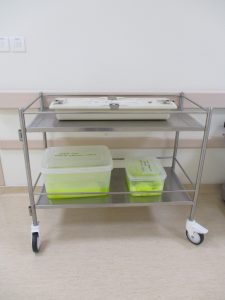Sterilization Process explains the full processing of the surgical products, instruments, materials used in medical and surgical practices
Decontamination is the process of making items safe for handling and before they are re-used. Cleaning, disinfection, and sterilization are procedures used to prevent contamination and spread of infection by medical instruments and equipment.
Cleaning
In contact with intact skin
Not in contact with the patient
Low infection risk
To be disinfected or sterilized
Example.
Bedframes, mattresses with impermeable covers, trolley tops
before use, work surfaces
Disinfection process
In contact with intact skin and mucous membrane
Contaminated with readily transmittable organisms
Medium infection risk
Metal tongue depressors, work surfaces, washing bowls, soiled
items, contaminated items, thermometers, infectious spills, e.g.
blood, urine on mattresses
Sterilization
In contact with broken skin or mucous membrane
Material that penetrates the skin or enters internal body areas during surgical procedures and examination.
Contaminated with readily transmittable organisms
Medium to high infection risk
Surgical instruments, dressings, reusable items such as sterilizable
Sterilization Process completes when it did not complete when sterilization over. After sterilization checks the label and store in damp free place to avoid fungal growth.
Sterilization of Syringes and Needles
Every member of the health team is responsible for carrying out cleaning, disinfection and sterilization procedures.
For safety, precaution staff responsible for cleaning, disinfection, and sterilization
Wash their hands with soap and water.
Be aware of the risks of contamination.
Wear thick, protective gloves.
Handle with care, when handling sharps and sharp instruments.
Follow the manufacturer’s instructions.
Storage
Storage of the sterilized sterile trays and bins in damp free rooms. Check the room walls and racks for the growth of fungal/algae
Maintain the Register for the no of tray sent and used
Resterilize if the sterile tray expired
Common tips for utilizing water for cleaning/Disinfectant
- Use clean water (ideally separated or bubbled) for cleaning, purifying and disinfecting
- In regions where faucet water and surface water have a high mineral or salts content utilize clean (separated or bubbled) water for cleaning, getting ready sterilization arrangements and sanitizing.
- Water with a high mineral or salts substance can harm hardware and instruments causing scaling, furring, and consumption of boilers and sterilizers. Bubbling or sifting does not decrease the mineral or salts substance of water yet will guarantee that the water is spotless.
- Use cool or warm water for cleaning not heated water. Boiling water causes protein substances, (for example, natural issue) to stick to instruments and gear